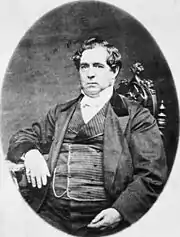Frontenac (Province of Canada electoral district)
Frontenac was an electoral district of the Legislative Assembly of the Parliament of the Province of Canada, in Canada West, based on Frontenac County. It was created in 1841, upon the establishment of the Province of Canada by the union of Upper Canada and Lower Canada. Frontenac was represented by one member in the Legislative Assembly. It was abolished in 1867, upon the creation of Canada and the province of Ontario.
| Defunct pre-Confederation electoral district | |
|---|---|
| Legislature | Legislative Assembly of the Province of Canada |
| District created | 1841 |
| District abolished | 1867 |
| First contested | 1841 |
| Last contested | 1863 |
Boundaries
Frontenac electoral district was located in the eastern area of Canada West (now the province of Ontario) on the north shore of Lake Ontario, at the entrance of the Saint Lawrence River. The town of Kingston was the major centre, although Kingston was a separate electoral district.
The Union Act, 1840 had merged the two provinces of Upper Canada and Lower Canada into the Province of Canada, with a single Parliament. The separate parliaments of Lower Canada and Upper Canada were abolished.[1] The Union Act provided that the pre-existing electoral boundaries of Upper Canada would continue to be used in the new Parliament, unless altered by the Union Act itself.[2]
The Upper Canada electoral district of Frontenac was not altered by the Act. It was therefore continued with the same boundaries in the new Parliament. Those boundaries had originally been set by a proclamation of the first Lieutenant Governor of Upper Canada, John Graves Simcoe, in 1792:
The boundaries had been further defined by a statute of Upper Canada in 1798:
The only change from those boundaries in 1841 was that the county seat, Kingston, was no longer included in Frontenac riding. The Union Act provided that Kingston was its own electoral district in the new Parliament.[5] The boundaries of Kingston electoral district were defined by the Governor General, and any parts of the town which were not included in Kingston electoral district were included in Frontenac.[6]
Members of the Legislative Assembly
Frontenac was represented by one member in the Legislative Assembly.[2] The following were the members for Frontenac.
| Parliament | Years | Member[7] | Party[8] | |
|---|---|---|---|---|
| 1st Parliament 1841–1844 |
1841–1844 | Sir Henry Smith |  |
Tory |
Abolition
The district was abolished on July 1, 1867, when the British North America Act, 1867 came into force, creating Canada and splitting the Province of Canada into Quebec and Ontario.[9] It was succeeded by electoral districts of the same name in the House of Commons of Canada[10] and the Legislative Assembly of Ontario.[11]
References
- Union Act, 1840, 3 & 4 Vict., c. 35, s. 2.
- Union Act, 1840, s. 16.
- Proclamation, Lieutenant Governor John Graves Simcoe, July 16, 1792; reprinted in Statutes of the Province of Upper Canada; Together with Such British Statutes, Ordinances of Quebec, and Proclamations, as Relate to the Said Province (Kingston: F. M. Hill., 1831) p. 24.
- An act for the Better Division of this Province, SUC 1798, c. 5, s. 14. Reprinted in The Statutes of Upper Canada to the Time of Union, Revised and Published by Authority, Vol. I - Public Acts (Toronto: Robert Stanton, Queen's Printer, 1843).
- Union Act, 1841, s. 17.
- Union Act, 1841, s. 21.
- J.O. Côté, Political Appointments and Elections in the Province of Canada, 1841 to 1860, (Quebec: St. Michel and Darveau, 1860), pp. 43-58.
- For party affiliations, see Paul G. Cornell, Alignment of Political Groups in Canada, 1841-67 (Toronto: University of Toronto Press, 1962; reprinted in paperback 2015), pp. 93-111.
- British North America Act, 1867 (now the Constitution Act, 1867), s. 6.
- Constitution Act, 1867, s. 40, para. 2
- Constitution Act, 1867, s. 70.
![]() This article incorporates text from a publication now in the public domain: Proclamation, Lieutenant Governor John Graves Simcoe, July 16, 1792
This article incorporates text from a publication now in the public domain: Proclamation, Lieutenant Governor John Graves Simcoe, July 16, 1792
![]() This article incorporates text from a publication now in the public domain: An act for the Better Division of this Province, SUC 1798, c. 5..
This article incorporates text from a publication now in the public domain: An act for the Better Division of this Province, SUC 1798, c. 5..